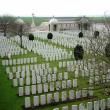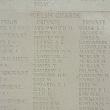Search our records : Arthur Percy Palmer
| Surname: | Palmer |
| Forename(s): | Arthur Percy |
| Force: | Army |
| Unit: | No 4 Company 1st Battalion Welsh Guards |
| Date of Death: | 27th September 1915 |
| Where Buried / Commemorated: | Loos Memorial |
| Decorations / Honours: | DSO |
| Civilian Occupation: | Mining engineer |
| Home address: | 26 Compayne Gardens, Hampstead, London |
Arthur Palmer's connection with Beer is still being researched. He clearly owned land in this area, as a farm in Musbury (Stocker's Farm) was among the bequests in his will, which is on his Army record in the National Archives at Kew. However he was born in West Ham, Essex in 1871, does not appear in Beer in the 1911 census, and was married in Hampstead, which was his home address at the time of his death.
He was commissioned as a Second Lieutenant in the East Surrey Regiment in January 1899[1] and served in the Boer War, transferring in South Africa to the Imperial Yeomanry (see below). He married Josephine Miles at Trinity Church, Hampstead on 23rd July 1902, and on 11th December 1909 they had a daughter, Pamela. At the time of his marriage he was a Captain in the South African Constabulary[2]. By 1911 he was on the General Reserve of Officers[3], i.e. no longer a regular soldier, but could be called up in the event of war.
Soon after the outbreak of the First World War, letters began to appear in the press in Britain lamenting the fact that Wales was the only country in the United Kingdom not represented by a regiment of Foot Guards. Lord Kitchener, as Secretary of State for War, shared this view, and on 26th February 1915 King George V signed a Royal Warrant authorising the formation of the Welsh Guards. On 1st March 1915, St. David's Day, the new regiment mounted guard at Buckingham Palace for the first time.
Arthur Palmer was appointed as commander of No. 4 Company. The regimental history gives an account of his background and his character as a soldier:
'Palmer, who was the senior captain and acted as second in command, was a fanatical fighter, which showed itself in his face, in his actions and in his record. In private life he was a mining engineer, and his military career started in 1899 in the 3rd Battalion East Surrey Regiment. When the South African War broke out he believed that his Militia would not be used, and he resigned his commission to enlist as a trooper in the 34th Company of the Imperial Yeomanry. Bald official record shows that he was given a commission in Africa, and rose to command this same company, winning a DSO and being twice mentioned in despatches. At the end of that war he joined the South African Constabulary, where he remained until 1907. He was a year in Zanzibar reorganising the police, and was in Rhodesia when war was declared with Germany. But he managed to be at first battle of Ypres as a captain attached to the Royal Horse Guards'.
'In the early morning of the 17th [August 1915] the battalion left Waterloo station for Southampton and France. One of the few civilians on the station to see them off was Mr John Burns, who, though a man of peace, has ever been a friend of the soldier. No doubt as he watched them he asked himself the same question as Palmer when the Battalion was being photographed a few days before leaving -- when the artist had said "Thank you", Palmer turned round, and, thrusting his great jaw out at the group said, "I wonder how many of us will be alive in six months time?"'[1]
Arthur Palmer was to die less than six weeks after this incident.
The battalion sailed from Southampton at 6pm on the 17th August on the SS Petersburg and arrived at Le Havre at 1am the following day. They then travelled to Arques to undertake training. On the 23rd September they moved to Fontes, and the following day were briefed on the attack in which they were to take part[2].
The battle of Loos began on 25th September 1915 as part of a larger attack which involved French troops staging a major offensive in the Champagne area while British and Commonwealth forces attacked further north, through the mining area around Loos and Lens. On 27th September the Welsh Guards, together with the 4th Battalion Grenadier Guards, were ordered to attack Hill 70 near Loos. The attack was made just before night fell. Arthur Palmer's Company, No. 4, was initially in reserve, but was later sent to fill the gap between the Welsh Guards and the 10th Hussars on their right. The regimental history describes in bald terms what happened when Arthur went up the hill to discuss the situation with the commander of No. 2 Company, whose men had taken cover behind a bank near the top of the hill:
'Palmer came up the hill and began to talk to Dick Bulkeley about the gap on the right of the line, but was immediately killed'[1].
In the attack on Hill 70 the Welsh Guards had 5 officers killed (including Arthur Palmer) and 6 wounded, one of whom later died. Twelve other ranks were killed, and 60 reported missing, while 99 were wounded[2].
On 2nd October 1915, Josephine Palmer received a telegram at her home in Hampstead:
Deeply regret to inform you that Capt. A. P. Palmer Welsh Guards was killed on 27th Sept last. Kitchener expresses his sympathy.'
On 15th October a wounded soldier, Corporal Everitt, was interviewed while on a hospital ship in Boulogne harbour awaiting evacuation to England. He gave this account of Arthur Palmer's death at Loos a few weeks earlier:
'I saw this officer killed at Hill 70 on September 27th. I was close to him at the time. He was hit in the chest and in the mouth and when he fell, he did not move again. His body was, I am afraid, left out for we had to come back to the trenches at the foot of the hill and he was in front. I do not know whether he was brought in afterwards but I fancy not. I was wounded last Sunday'[3].
The regimental history describes something of Arthur Palmer's relationship with his men.
'His company, No. 4, or what is left of it, has never forgotten him, and his photograph will be found in several houses in Wales. He looked after the bodily comforts of his men down to attending to their blistered feet himself, but when one of them bobbed at something which whizzed over his head in the streets of Loos Palmer sprang at him and shook him like a rat'[1].
Most of the dead from the Battle of Loos were not recovered until the war ended in 1918. As a result, a very high percentage could not be identified. Arthur Palmer has no known grave, and his name appears on the Loos Memorial, one of 14,000 men killed in the Battle of Loos whose bodies could not be identified[2].
Josephine Palmer was awarded a gratuity of £250, and a pension of £100 per year. Her daughter, Pamela, received a gratuity of £83 6s 8d and an allowance of £24 a year[3].
[1] History of the Welsh Guards, C. H. Dudley Ward. p.38.
[2] 1915: The Battle of Loos, Commonwealth War Graves Commission
[3] Army record, National Archives, Kew.
[1] History of the Welsh Guards, C. H. Dudley Ward, p. 34
[2] War Diary, 1st Battalion Welsh Guards, National Archives, Kew
[3] Army record, National Archives, Kew
[1] History of the Welsh Guards, C. H. Dudley Ward, p. 37-38
[2] War Diary, 1st Battalion Welsh Guards, National Archives, Kew
[2] Army record, National Archives, Kew
[3] London Gazette, 28th July 1911


